Investigation of the Magnetosphere of Ganymede with Galileo's Energetic Particle Detector
Ph.D. dissertation by Shawn M. Stone, University of Kansas,
1999.
Copyright 1999 by Shawn M. Stone. Used with permission.
1.5 Charged Particles in the Vicinity of Ganymede
There are two instruments aboard Galileo that measure the population, trajectory, and angular distribution of energetic charged particles in the Jovian magnetosphere. The first is the plasma instrument (PLS) which measures particles in the energy range of 9 eV to 52 keV [Frank et al., 1992]. The second is the Energetic Particle Detector (EPD) which is discussed in detail in Chapter 3. Figures 1.24 and 1.25 show the particle data of feature 19:00:09 for three energy channels for the electrons and ions for the G2 encounter. Figures 1.26 and 1.27 show the particle data for three energy channels for the electrons and ions for the G7 encounter. One of the most dramatic features of this set of particle data is the downward spikes seen at periodic intervals within the Ganymede system during the G2 and G7 encounters. They are observed in both the electron and ion channels and are loss cone signatures, and probably result from the impact of particles on Ganymede [Williams et al., 1997].
 |
Figure 1.24 The electron rate profiles of three energy passbands of the EPD detector for the G2 encounter. The downward spikes are loss cones attributed to Ganymede and are present in all electron and ion species. |
 |
Figure 1.25 Ion rate profiles of three energy passbands of the EPD detector for the G2 encounter. The downward spikes are loss cones attributed to Ganymede and are present in all electron and ion species. |
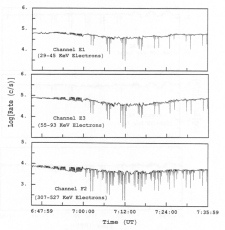 |
Figure 1.26 The electron rate profiles of three energy passbands of the EPD detector for the G7 encounter. The downward spikes are loss cones attributed to Ganymede. |
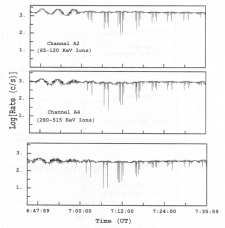 |
Figure 1.27 The ion rate profiles of three energy passbands of the EPD detector for the G7 encounter. The downward spikes are loss cones attributed to Ganymede. |
For G2, loss cone signatures are observed whenever the EPD instrument peers down the magnetic field toward Ganymede. All ion channels display a single loss cone when looking down a field line towards the moon, as shown in Figure 1.28. The electron channels are more interesting; all energies displayed an empty loss cone when looking toward the moon. However, in the anti-moon direction, electrons displayed nearly full loss cones at low energies and empty at high energies, as shown in Figure 1.29. This double loss cone is attributed to the fact that the electrons are able to bounce several times between Ganymede and the Jupiter bounce point as they convect across the magnetosphere. The filling in of the conjugate loss cone is done by pitch angle scattering along the bounce trajectory [Williams et al., 1998]. Williams and Mauk [1997] have used this unique effect to calculate the pitch angle diffusion coefficient on these Ganymede-Jupiter field lines. Figure 1.30 shows this result for feature 19:00:09. Loss cone signatures were not observed in the interval of 18:50:00 to 18:54:00 because the EPD stepping sequence did not sample small enough pitch angles.
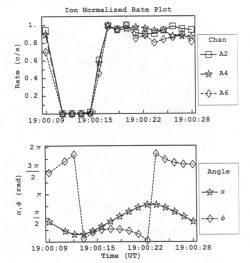 |
Figure 1.28 Normalized rate plot of feature 19:00:09 for three ion channels. The second panel shows the pitch and phase of the detector relative to the magnetic field vector. When EPD peers along the field <60°, there is a complete loss cone. However, when EPD peers in the opposite direction, there is no apparent loss cone signature. |
 |
Figure 1.29 Normalized rate plot of feature 19:00:09 for three electron channels. The loss cone can be seen in all three electron channels when EPD peers along the magnetic field towards the moon. For the E1 and E3 channels, it can be seen that there is a shallow loss cone in the anti-moon direction. The conjugate loss cone is nearly completely empty for the F2 channel. |
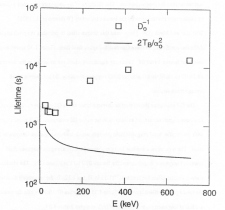 |
Figure 1.30 The electron lifetimes based on feature 19:00:09. The squares represent the data based on a weak diffusion process. The solid line shows the minimum lifetimes expected from strong diffusion [Williams et al., 1997]. |
The G7 encounter shows similar characteristics as the G2 encounter. However, the loss cone signatures are not as deep as those at the G2 encounter. This is consistent with the smaller local magnetic field strength which leads to a smaller Ganymede loss cone. The ions show a shallow loss cone when looking along the magnetic field towards Ganymede, demonstrated for feature 07:11:13 in Figure 1.31. The electrons show a similar effect for feature 07:11:13 in Figure 1.32. In the anti-moon direction, the ions again are filled, as shown in Figure 1.33 for feature 07:10:14, while the electrons are full at low energies and shallow at high energies (Figure 1.34).
 |
Figure 1.31 Normalized ion count rates of feature 07:11:13 for the G7 encounter. A loss cone is shown for a <=45° in all ion channels. |
 |
Figure 1.32 Normalized electron count rates of feature 07:11:13 for the G7 encounter. A loss cone is shown for a <=45° in all electron channels. |
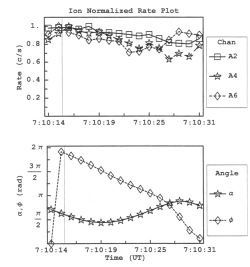 |
Figure 1.33 Normalized rate plot of feature 07:10:14 for the G7 encounter for three ion channels. This feature demonstrates that the loss cone in the anti-moon direction is filled in by corotating plasma ions. |
 |
Figure 1.34 Normalized rate plot of feature 07:10:14 for the G7 encounter. Three electron channels are shown. This feature shows the anti-moon loss cone for the F2 channel and filled loss cones for the lower energy channels.. |
Next: 1.6 Thesis Overview
Return to dissertation table of contents page.
Return to main
Galileo Table of Contents Page.
Return to Fundamental
Technologies Home Page.
Updated 8/23/19, Cameron Crane
QUICK FACTS
Mission Duration: Galileo was planned to have a mission duration of around 8 years, but was kept in operation for 13 years, 11 months, and 3 days, until it was destroyed in a controlled impact with Jupiter on September 21, 2003.
Destination: Galileo's destination was Jupiter and its moons, which it orbitted for 7 years, 9 months, and 13 days.



